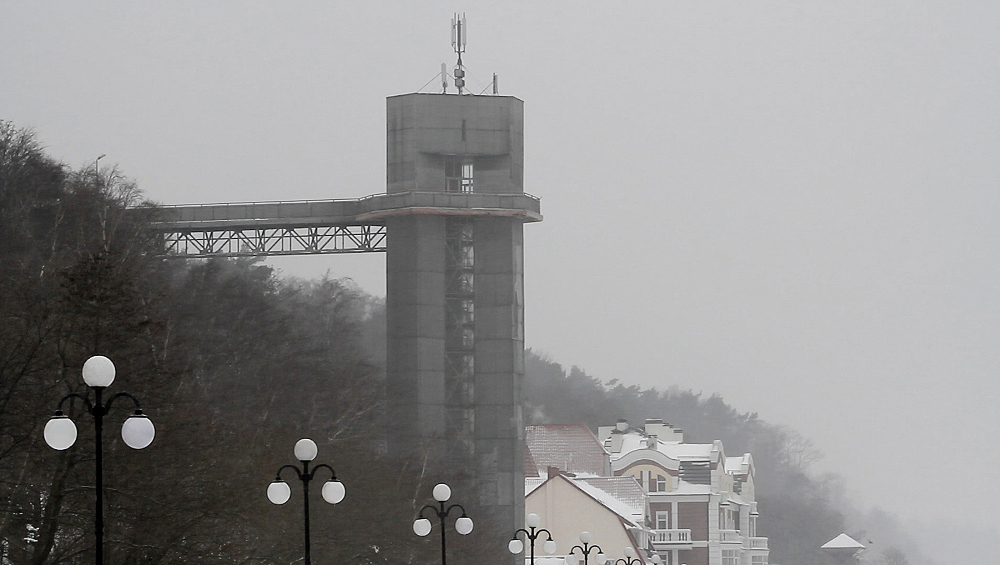
Kristina Inčiūraitė, The meeting, film still
On 28th March, 6 pm The Łaźnia Centre for Contemporary Art (Łaźnia CCA) (Gdańsk Nowy Port, 5 Strajku Dokerów Str., Poland) opens The Meeting. Stolen Past exhibition by Kristina Inčiūraitė and Cooltūristės.
The exhibition is an artistic exploration of the female gaze and utopian Soviet architecture as a memory landscape. The modern cityscape has been transformed in three ways: semantically, functionally and personally. The semantic layer involved renaming streets and buildings. The functional aspect meant changing their function and architectural structure. The personal transformation refers to the reinvention of a fictional past based on the new reality. Films by Kristina Inčiūraitė and Cooltūristės uncover all three layers of the hidden past in different locations. Soviet modernist buildings are still haunted by the past, but old myths generate new stories and performances.
Time travel through memory, uncovering a lost “cosmic” landscape, is the main theme of “Space Kindergarten” (2012) by Cooltūristės. The Space Kindergarten was built by the architect Viktor Cholin from Moscow. Its rounded shapes recalled the utopian architecture of an unknown civilization, or the design of a spaceship. The kindergarten was used as a platform for an imaginary “Moon Mission”. It served as a time machine, enabling the testing of different scenarios of the past and the future, and the performance of a journey through the memory.
The space race of the Cold War did not unfurl only in space. It was also reflected on Earth. The shops called “Mercury”, “Saturn”, “Comet” and “Rainbow”, the trolleybus stops called “Moon”, “Stars”, “Lightning” and “Thunder”, the children’s club “Meteor”, and “Cosmonaut Avenue”: all these existed in a residential area on the outskirts of Vilnius. These names were changed after 13 January 1991: the streets were renamed after dead heroes; and the semantics of the area shifted from outer space to a symbolic cemetery. A hidden pet cemetery has appeared in the nearby woods in recent years, adding a different dimension to the myths of space and immortality. Inspired by this transformation Žygimantas Kudirka wrote a poem about animal in space.
Another important modernist building is the Wedding Palace in Vilnius (built in 1974). It is famous for its long outside staircase. After the wedding ceremony, each bride performs the ritual of “descending to Earth”. An early video by Kristina Inčiūraitė, “Downstairs” (2000), questions the symbolic meaning of the architecture. Dressed in a wedding dress, the artist descends the staircase of the Wedding Palace four times, with four different men, but none of them is her husband. More than ten years later, Cooltūristės repeats the performance backwards, challenging the patriarchal ritual through the collective spirit of rebellion and the emancipation of women (“Upstairs, or Wedding International”, 2013).
In a new experimental documentary, “The Meeting” (2012), Kristina Inčiūraitė presents her correspondence with a female of the same age, resident in the town of Svetlogorsk, who is seeking new acquaintances on the Internet. The artist uses a male name (and her husband’s identity, mixed up with her own), and does not disclose to her correspondent that this is part of an art project. Mutations of identity are combined metaphorically with the ambiguous situation of the Svetlogorsk seafront cable car. This is a huge and imposing construction, which is being destroyed by the effects of erosion. The film reveals how the cable car and the associated story of the correspondence capture the junction of utopia and dystopia.
Another important issue in the exhibition is questioning the strategies of appropriation by turning them inside out. This is not only appropriation, but also misappropriation, the exposure of an error, grabbing publicity by using one’s weakness – “Miss”. “Miss”appropriation is a female appropriation, the subjection of hard male buildings to soft female materials. Misappropriation as a “wrong” appropriation: subjecting architecture to performance, the body to photography, photography to sculpture, and vice versa.
We can recognize mis(s)appropriation when Kristina Inčiūraitė chooses not to show women in her videos, and presents their voices instead, to avoid turning them into objects of desirous male gaze; or in the ‘changing gender’ of allegorical statues by Cooltūristės.
In order to avoid commoditization of female image, Inčiūraitė shows women indirectly, metonymically. Instead of looking at the huge allegorical sculpture in Kiev (“Mother”, 2013) the viewer is taken inside her and becomes her eyes: s/he sees what the giant sculpture is seeing.
The female gaze plays very important role in the video films of Cooltūristės as well. In contrast to the objectifying male gaze, fixed on vertical embodiment of power, a female gaze is seen as an opening of the horizon, unfolding time-based horizontality. In the video “Reading faces” (made together with Estonian artist Mare Tralla in 2011) Cooltūristės concentrate on silent conversation of women’s gazes and how the true feelings can be only read from a woman’s face. It is an attempt to rethink woman’s place in film and real life. Film characters exchange glances with the artists present on the screen nearby (“Angled Towards the Other”, 2011), who are marking the horizon of the gallery space, uniting gazing subjects and objects.
Kristina Inčiūraitė and Cooltūristės uncover the links between imagined and real history in their films and performances. The stolen past returns to the present, to inspire different visions of the future.
Curator: Laima Kreivytė
Organizer: Klaipeda Culture Communication Center (Lithuania)
The Meeting. Stolen Past exhibition in Gdansk runs until 2014 April 27th.
For more information about the project, please visit the website www.closestranger.eu.
























